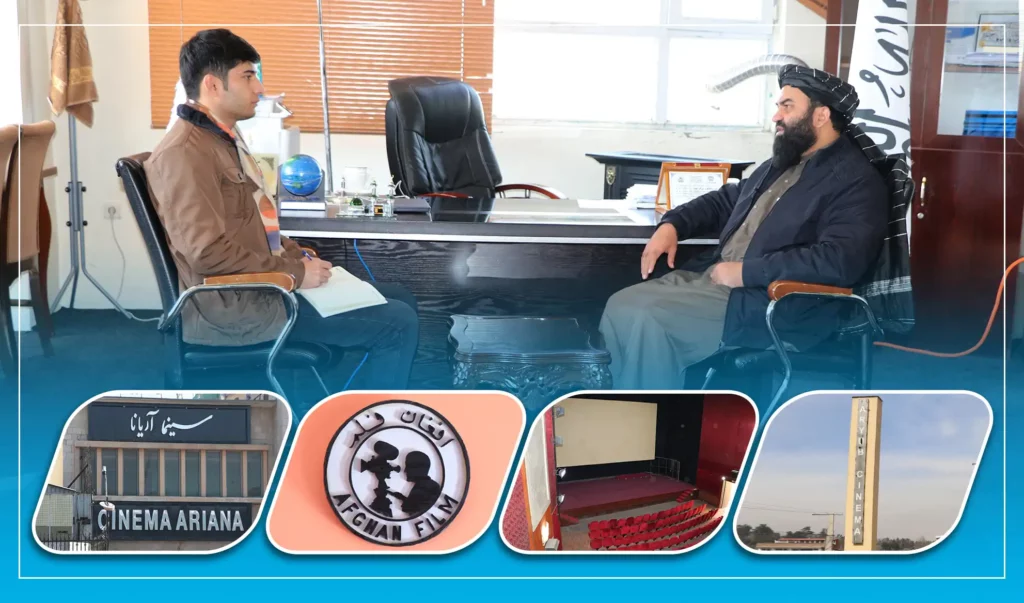KABUL (Pajhwok): Some people thought that cinema would be banned after the takeover of the ‘Islamic Emirate of Afghanistan’ (IEA) but contrary to the mindset nine movies had been made during post regime change period and a festival was also held in the Aryana Cinema hall.
But cinema activists and artists believed the number of movies produced during the period was little and more work should have been done.
According to official documents former King Shah Amanullah Khan for the first time brought cinema projector with himself from his European trip and in 1928, the first movie was set on display for public in Paghman district.
During democracy period from 1965 to 1971 cinema was fully active in the country and was opened for public for some 30 years but later the entertainment industry stopped functioning or could not continue due to conflict.
Qari Wai Gul Jawad, the cultural affairs director of Kabul Municipality, said five cinemas existed in capital Kabul. The only active cinema was the Aryana Cinema and the remaining were closed during the past government.
During the first rule of the IEA, watching movie and hearing music was not allowed, but currently, there was no ban on watching movies but nine movies had been produced during this period by Afghan Film which a state institution.
Kabul municipality said efforts would be made to keep the cinema open and provide support to the industry.
Abdul Azeem Karimi, deputy head of production and technical affairs of Afghan Film, said after the takeover of the IEA, nine movies — Zindan-i-Bagram, Pul-i-Kampani, Salang Highway, Kabul Retaining Walls, Activities of Afghan Fim, Yak Roz Kari Qumandan Amnia, Baghban Dawlati, Satonki and Nuham Sunbula — had been produced.
He said after regime change some artist lift the country while some artists were busy with their projects but economic problems existed.
Karimi added cinema and film making was not possible without money and Afghan film did not received normal or development budget from government so far.
When asked about curbs on film making, he said until now he did not witnessed any restrictions from the government and if some individuals faced any problem they might acted on their own without informing Afghan Film or might did something against the law.
Rahmatullah Khosti, deputy head of the Cinema Artists Union, said the production of Rahi Pak serial and Did-i-Naw festival were the important event arranged and held after regime change. He added cinema in Afghanistan was moving in the right direction.
He said in the past plays were produced which were against the culture of Afghan society, adding that in some cases these materials insulted a specific ethnic group, tribe and section of society but right now no such violation existed.
“We should have our own production that represents our culture,” he stressed.
He added Islamic values and national culture was vital for the IEA and they were prepared work in line with these two principles.
Mir Ahmad Qadir, a cinema artist, Political changes in the country always hurt cinema in the country, every government paid little attention to the promotion of cinema in the country.
Referring to the current state of cinema Qadari said it was not acceptable to them and added that the IEA, according to the promises it made, should provide more opportunities for the work of cinematographers and invest in cultural sectors.
He said When the Emirate came back to power, the majority thought that there would be no such thing as cinema, culture and television, but today everyone is witnessing the activities in these fields
Syed Habibullah Sadaat, director and cinematographer, pointed out that currently the financial support for cinema is very low and asked cultural institutions and the international community to support Afghan cinema
He added the amount of films produced during this period is not enough and more attention should be paid in the field of cinema and more films should be produced..
Wali Gul Jawad, Kabul Municipality Cultural Affairs director, said five cinemas existed in capital Kabul four of which stopped functioning during past government or suffered infrastructure damage. The only active cinema was the Aryana Cinema where some movies are put on display.
He added after the takeover of the IEA no cinema had been damaged and the EIA was not against cinema culture in the country and wanted things against the mindset and culture of the people not to be screened, he also stress foreign culture should not be displayed in cinemas as well.
He said a joint government committee had been forced to work on cultural related subjects; the committee is comprised from the representatives of cultural ministry, Kabul municipality and Amri-bil-Marof Ministry.
Some civil activists and common people believed that cinema had a positive impact on public mindset.
Waheed Ahmad Alkozai, a civil society activist, said culturally and morally cinema has positive impact on a society and it can help enlighten the mindset of people in a society.
Rahmatullah, another resident of Kabul, said in the past cinema was active; besides negative points it had more positive points and people learned from it.
He asked the IEA to pay attention to the cultural development and take more steps for the promotion of cinema culture in the country.
nh
Views: 224









GET IN TOUCH
NEWSLETTER
SUGGEST A STORY
PAJHWOK MOBILE APP